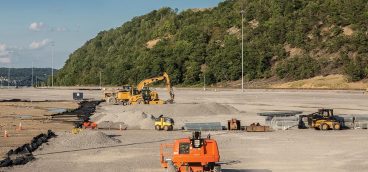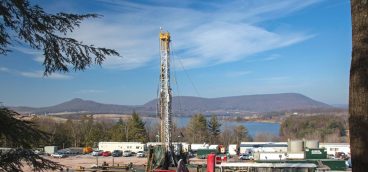Does This Change Everything?

It’s been nearly six months since the state Supreme Court rocked Pennsylvania by striking down key portions of Act 13, Gov. Corbett’s signature legislation on Marcellus Shale drilling.
But even now, the full impact of the decision—and what it bodes for the future of the drilling industry in the state—remains unclear. In fact, say legal experts, it could take years—and a lot more litigation—before all the ramifications of the decision are known.
That’s not because the decision was unclear.
In fact, there is little question that the court’s blistering 4-2 decision handed down in December in Robinson Township v. Commonwealth of Pennsylvania was a bombshell, say legal experts and advocates on both sides of the increasingly volatile debate over the future of the Marcellus.
In an unusually caustic 162-page opinion, Chief Justice Ron Castille, joined by two other justices, struck down the portions of the legislation that effectively stripped municipalities of the authority to use zoning to restrict where oil and gas development could take place. A fourth justice concurred with the ruling that also ordered the lower court to revisit a case brought by a Pennsylvania doctor who challenged provisions in Act 13 that restricted health care professionals from sharing information about proprietary chemicals used in the drilling process.
Perhaps most important, however, was the point of law on which Castille, and the two justices who joined him, based the legal opinion. The plurality decision crafted by Castille catapulted a 40-year-old constitutional amendment—the Environmental Rights Amendment—to the forefront of the debate over the state’s rights and responsibilities when it comes to oil and gas drilling.
Adopted by the legislature in the 1970s and overwhelmingly endorsed by the voters during the early days of the environmental movement, the amendment was largely designed to respond to the toxic legacy of a century of environmental damage wreaked by the pursuit of coal, according to the amendment’s author, former Northumberland County Sen. Franklin Kury. In effect, the amendment declared that the people have a right to clean air and clean water, that sites with historic and aesthetic value were a communal legacy, and, most important, that the state has a duty as the trustee of those resources to conserve them for future generations.
As sweeping as the language of the amendment is, for most of its existence, the amendment’s impact was largely inspirational; it served primarily as a kind of mission statement for lawmakers and regulators to consider when developing policy, Kury acknowledged, adding, “I would say it was under appreciated.”
That’s not to say the amendment had no tangible effect, Kury said. “For almost 40 years, a lot of stuff was adjusted for the environment. The courts themselves didn’t push that very far but the agencies did. The Fish and Game Commission used the amendment on their literature. The Department of Environmental Protection said if you wanted to do anything to the environment you had to fill out form 54… saying what you would do to the environment and how you would minimize it. That was never done before.”
But when it came to the courts, the amendment was rarely cited, and when it was, it was most often in the context of local disputes over specific developments.
For four decades, there was never a case that tested the limits of the amendment. That all changed in December when the Castille court issued its opinion. In his opinion, Castille for the first time in the amendment’s history used the amendment to halt an act of the Legislature. Calling Act 13 “a revolution… worked… upon the existing zoning regimen in Pennsylvania,” Castille wrote that the “protection of environmental and aesthetic interests is an essential aspect of Pennsylvanians’ quality of life” which, he wrote, was protected by the Environmental Rights Amendment, Section 1, Article 27.
And in a passage that stunned even opponents of the drilling industry, Castille argued that by “any reasonable account, the exploitation of the Marcellus Shale formation will produce a detrimental effect on the environment, on the people, their children, and the future generations, and potentially on the public purse, perhaps rivaling the environmental effects of coal extraction.”
In short, Castille found, the state certainly has the authority and the responsibility to set statewide regulations on issues surrounding gas drilling. And it also has the responsibility to foster economic development, he argued. But those responsibilities must be “limited by constitutional demands, including the Environmental Rights Amendment.”
The ruling triggered an avalanche of predictable responses, perhaps fueled in part by Castille’s blunt assessment of the environmental impacts of the drilling industry. The Corbett administration immediately asked the court to reconsider its ruling, arguing that the court had made “a series of sweeping factual conclusions” about the constitutionality of the law and was in error.
Former Department of Environmental Protection Secretary Michael Krancer, who now handles energy issues for the law firm Blank Rome, went even further. “It is breathtaking in terms of what it could mean,” he told Pittsburgh Quarterly. “And all based on imaginary facts. I mean that’s the shocking thing. Castille talks about the negative environmental impacts that are associated with this, and none of those facts are in the record. None of them are true. That’s what Act 13 was all about—balancing the need for environmental stewardship and the rights of others to engage in lawful activities, commercial activities. For the Supreme Court plurality opinion to talk about these horrible impacts is quite fanciful.”
On the other side of the vast political divide over fracking in Pennsylvania, environmental groups praised the ruling. Adam Garber, field director for PennEnvironment, called the decision “significant” and predicted it “will shift environmental legislation. It wasn’t one of those decisions you read that… hems and haws or tries to narrow the scope. It very clearly said there are significant health and environmental impacts from gas drilling and those consequences are being felt.”
While some in the administration have warned that the ruling could undermine some environmental protections—the law established minimum distances that wells must be located from water supplies, for example—most experts agree the sweeping decision will have little immediate impact. For now, drilling permits will still be issued, and drilling will continue apace.
Most experts agree that it will take years, perhaps decades, to “unpack” the decision’s potentially far-reaching significance—not just on the drilling issue, but on a host of untested conflicts between the twin imperatives of environmental protection and economic expansion in the state.
John C. Dernbach, a Widener University law professor whose work on the amendment was cited in the decision, said the future impact of the recent decision depends entirely on whether courts decide to apply the decision in future cases.
The question, he said, is will those future courts in future cases back away from Castille’s reliance on the Environmental Rights Amendment, or will they expand it, in essence turning that plurality into a majority opinion with the legal force of precedent.
For his part, Dernbach believes the December decision is likely to be the first of many that draw on the amendment. “It’s the first time that Article 1, Section 27 has been used… to hold a statute unconstitutional. And I don’t believe this is the last time.”
Of course, no one can predict precisely how future courts might interpret or apply the Castille ruling, said John Quigley, former head of the state Department of Conservation and Natural Resources (DCNR) in the Rendell administration. And in the meantime, the fact is that the decision has created “some uncertainty as to the long term.”
And that, experts say, is precisely why an obscure case filed against the state by the Pennsylvania Environmental Defense Foundation (PEDF) could in time end up being a landmark case.
The PEDF case was in many ways overshadowed by the Robinson case on which Castille issued his opinion, and the issues at stake in the PEDF case are significantly narrower than the challenges raised in the Act 13 case. In essence, PEDF contends that the state’s efforts to permit drilling on publicly owned lands—state forests and perhaps state parks—should be halted. Critical to their argument is their allegation that the state has violated the Environmental Rights Amendment by siphoning funds from the state’s Oil and Gas Lease Fund that were earmarked for DCNR to be used instead for general budget purposes. In essence, the PEDF case alleges that any revenues generated by gas and oil leases on state lands must be dedicated specifically to the DCNR to fulfill its constitutional mandate to act as the public’s trustee to protect and conserve the state’s natural resources. Diverting those revenues to the general budget was, PEDF contends, a violation of the Environmental Rights Amendment.
In effect, said PEDF lawyer John Childe, the entire PEDF case pivots on the Environmental Rights Amendment, and specifically on the state’s responsibility to act as the public’s trustee under the terms of the amendment.
“Our case is mostly constructed on the trust aspects of Article 1, Section 27,” he told Pittsburgh Quarterly. “We are arguing that we are harmed… that our members’ rights to the corpus of the trust have been harmed.”
The PEDF case is in its earliest stages. There’s no telling how a lower court might decide it. And there are those who question whether, even if it does work its way up the judicial ladder to the state Supreme Court, it would be the proper case to test the legal durability of the Castille decision.
But Quigley, who has consulted with the environmental defense group on the case, contends that the case has become a lot more important since the Castille decision and could well turn out to be the logical next step in the evolution of the law surrounding the Environmental Rights Amendment. “That Act 13 decision is almost tailor-made for John’s case,” he said. “Now will a court look at that and cite it as precedent? It’s hard to say. But it’s a helluva thing to have.”
As Widener University’s Dernbach put it, the key question answered by the Castille decision was whether the Environmental Rights Amendment could be used to declare a state statute unconstitutional. The answer, according to a plurality of the justices, was yes.
“The key question in the PEDF case also involves the constitutionality of a statute,” he said. “Now, are the facts different? Yes. But in a fundamental sense, the most obvious next step in the development of Article 1, Section 27 law is a court decision in which a majority decides that the amendment can be used… to challenge the constitutionality of the statute. Could this be the case that does that? Yes.”





